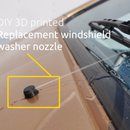Introduction: EEPROM Flash Drive (Flash Drive Case)
Here's a quick instructable of something I did one 'rainy' day. I have a 1GB flash drive I'd gotten at a Goodwill Outlet for literally almost nothing, that I intended to make a custom case for. I used an old EEPROM chip I had to kind of cover the flash drive.
I don't really intend this to be a "Follow these instructions" type of instructable, but rather to inspire some of you to make something cooler. ;)
Step 1: What You'll Need
Ready to make your own USB-chip flash drive? Here's what you'll need:
- A USB flash drive, preferably not extremely valuable or with any important data on it (I'm not responsible for you ruining your drive or losing your data)
- Some stuff for filing/sanding down plastic
- At least one 28 pin DIP chip (It can be longer or shorter, you'll just need to decide based on the length of your drive) You could also use two chips, one on top, and one on the bottom, but it'd be thicker that way.
Step 2: Get the Chip/s
Now that you know what you need, time to get what you need! The hardest thing to find, most likely, will be the chip. I didn't want to use a chip that was of any real value or still worked (I did end up using one that probably still worked, but I didn't damage it in any way). If you want a gold/ceramic chip, you may be able to find a lot of them labeled as "For scrap" that have broken/mangled pins and are somewhat dirty. These you can feel ok about gluing on top of a flash drive. ;)
I was lucky enough to have an old pinball circuit board with some Intel EEPROMs on it, so I just used one of them, but if you don't have an old circuit board laying around, look on ebay for "scrap gold chips". It looks like the larger lots go for pretty high prices, but if all you want is one chip, you can get smaller lots, or resell the extras when you're done. (You could also just ship them to me, I don't mind! ;P)
Step 3: Prepare the Flash Drive
Now you're ready to put it all together, but wait! You still need to prepare the flash drive!
My flash drive fit between the pins perfectly width-wise, but I wasn't too happy about how tall it was, so I decided to sand down the top and bottom plastic parts to make it thinner. You don't have to do any of this, it depends on how you want it to look.
I tried several methods, using a couple different files, and a couple different sandpaper grits. I eventually found that 180 grit works well for removing bulk amounts, and 220 works well for smoothing it out more. Finer grits work better for getting a shinier finish.
Carefully use a small screwdriver to remove the plastic cover on the flash drive. You don't want to destroy the flash drive with your screwdriver, nor do you want to accidentally sand down the memory chip. ;)
Step 4: Sand/file the Plastic Cover
Now, start sanding!
You can use a power sander if you wish, but just remember to be careful not to sand too much off! I enjoy making stuff completely by hand (Without power tools), so it took longer for me. You can do it either way. Be careful not to sand too much though.
Step 5: Keep Sanding!
If you're doing it by hand, patience is a virtue. However, there's times when it might be better to use a different tool.
I started out using files, but didn't like how long they were taking, so I used sandpaper for the rest. Check every now and then to see how much is left to do. If whatever you're using isn't fast enough for you, you can try a different method. If you prefer the wait, go ahead! We'll see you with your masterpiece later and wish we'd taken at least a bit longer.
Step 6: Finished Sanding! (Finally!)
Think you're finished sanding?
Check to make sure any knobs are smooth, make sure the plastic pieces still fit smoothly and don't wobble on the underside of the chip. If it all looks (and feels) good to you, then you're ready for the next step!
Step 7: Assemble (Glue)
Now let's put together our masterpiece.
I had to go and botch the whole thing by using hot glue, so go ahead and curse me for it. You could use hot glue, but I prefer not to (At least for a finished product, which this hopefully isn't). You could use some sort of molded epoxy, or modeling clay, or wood glue, or whatever you want. Basically something that will hold it all together. Try and make it look good though.
First, glue the plastic cover back on to the flash drive. I chose to not use the top cover, because it took up too much space, and didn't look much worse without it. Remember though, that if your flash drive's USB connector is part of the circuit board (Like mine was), you'll need the plastic bit that stabilizes it in a USB port. If it's a normal plug, it's fine.
Next, glue the chip on top with the glue/whatever of your choice. Now your drivce is assembled, but it probably isn't quite done yet.
Step 8: Finishing Touches...
Here, it really depends on how you did it, but I'll tell you what I did.
I used an exacto knife to cut off the excess hot glue, then sanded the pins lightly to get rid of the little straggles of hot glue that were hanging around. It also made the pins shinier. (I wouldn't do this if they were gold though, since it's likely only a thin plate)
I also used a pair of pliers to fold the pins over the bottom of the flash drive, so that they weren't sticking out.
Step 9: Finished!
I hope you enjoyed this project! Feel free to comment with any ideas or suggestions you have!
This is entered in several contests, so feel free to vote if you liked it!
Many thanks to Antzy Carmasaic for his instructable on making pure white backgrounds, it's helped a lot in this instructable! Here's his 'ible on it: https://www.instructables.com/id/Pure-White-Background-Photography-Using-Smartphone/

Participated in the
Rainy Day Challenge

Participated in the
Before and After Contest 2016

Participated in the
Full Spectrum Laser Contest 2016













